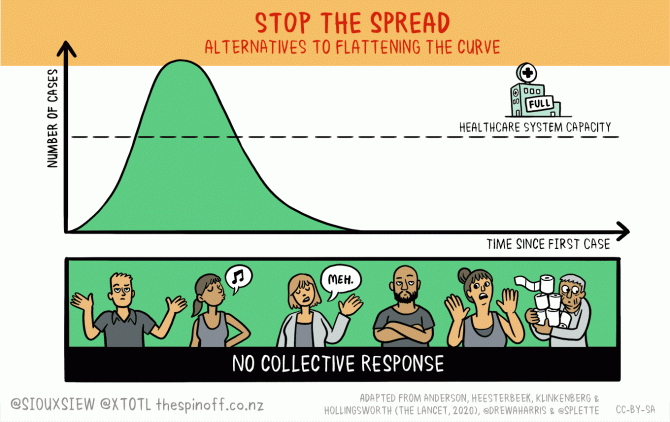In some ways this session is an odd choice of event for a literary festival. Because although scientist Siouxsie Wiles and graphic artist Toby Morris have both authored books, this session was specifically focused on their collaboration on, well... gifs (animated images).
But it couldn't be more timely or current and gifs or not, collaboration and the goal of communicating with an audience are topics common to other creative outlets.

Wiles, as a scientist, believes that "...science doesn't end with the publication of your scientific paper". For her, helping people to understand her work is actually part of being transparent about the tax dollars that are being spent in the process. "Transparency" is a word that she uses more than once during the course of the session and seems to form part of her core values.
Their first collaborative effort, a "flattening the curve" animated graph came about because Wiles was writing a piece for The Spinoff and had asked for a graphic to be included. Editor, Toby Manhire approached Morris, who had already worked with The Spinoff, and together he and Wiles modified an already existing graph, with Morris changing the colours from red and blue (to remove an political associations) and including characters to help show how individual actions could have an effect.
In some ways Morris's lack of scientific background is an advantage.
Siouxsie is trying to figure out how to talk to members of the public who don't know anything about science... and that's me.
Despite its success (being shared widely) or likely because of it, Wiles regrets this graphic as it soon became clear that simply slowing the spread of the virus (while still allowing people to become sick) was not the best strategy. Wiles' change of thinking was based on a Lancet report, published on 13 March. She and Morris would then produce "Stop the spread". Both graphics were published in the same week, and prior to the announcement of COVID-19 lockdown in New Zealand.
For Wiles it's heartbreaking that "flatten the curve" became the global message when elimination, "stop the spread" is the strategy that's worked so well in New Zealand.
The rapidity of changing information around COVID-19 helps demonstrate Wiles's approach (and that of science, generally), that when faced with new, more up-to-date information, you can change your opinion. Scanning the horizon, re-assessing, and making changes accordingly are simply the scientific way of approaching things.
The gifs (which all have a Creative Commons license) have been used around the world, and modified using different languages.
I've always felt that illustration was an effective way of conveying a message.
So the popularity of the gifs are something of a vindication for Morris. In fact, they've been so successful that 4 or 5 months ago the World Health Organisation got in touch, with Morris quipping that Duncan Grieve, of The Spinoff, initially "thought it was spam". Their subsequent mask explainer has been viewed 40 million times.
Wiles spoke a bit about how some people seem to be very upset about her striking, unabashedly pink hair which she has dyed this colour since she was in her 20s. For Wiles it's a way of challenging people's ideas about who can be a scientist.
Wiles addressed the issue of misinformation and the fact that people can make videos that seem very professional but which simply don't have the evidence to back up the claims being made. These videos are being produced at such a rate that you can't debunk every single one.
Questions from the audience included someone who wondered whether science communication should be a required component of scientific courses of student. Wiles pointed out that this needed to be a criteria in decisions made by funders, since that's what will drive uptake.
Someone else wondered if Morris could turn his skills to explaining climate change, which he admitted he had struggled to boil down as it's such a complex issue, but that it certainly shared the same theme of needing a collective response.
It seems in every literary festival there must be at least one "this isn't as much a question as it is a comment" moment, though to be fair to this person she did reframe it as a question (as there were many audible groans when she said this). She enquired of Wiles "How can I verify what you say is right?". Which actually, is quite a good question, given that a worrying number of people seem to really struggle with assessing what's good information and what's rubbish. Wiles encouraged her to read the John Snow memorandum (originally published in The Lancet last month, at time of writing it has been signed by nearly 7000 scientists, researchers and healthcare professionals), and said that basically people need to be able to provide their evidence.
However the questioner seemed to need more than this and started in with a "...but..." only to have Wiles cut her off, "...come and talk to me at the end but let's not get into an argument here."
https://twitter.com/SiouxsieW/status/1322738248850923520
So to sum up: Science doesn't care what colour your hair is, visual communication can be really effective, and evidence, evidence, evidence.
More information
- WORD Christchurch website (for the full programme and info about authors)
- Follow WORD Christchurch on Twitter and Facebook
- Read our WORD Christchurch Spring Festival 2020 coverage
- Articles by Siouxsie Wiles on The Spinoff.
- The bumper Toby Morris & Siouxsie Wiles Covid-19 box set at The Spinoff
- Blog post about Fake news




Add a comment to: WORD Christchurch: Going viral